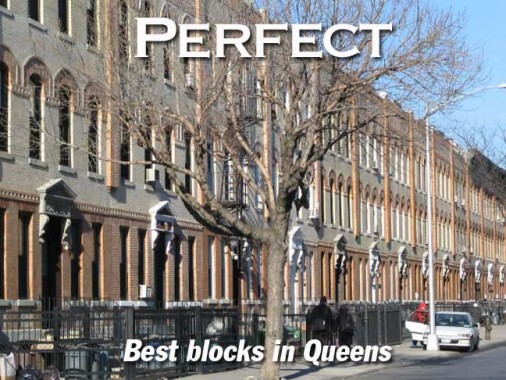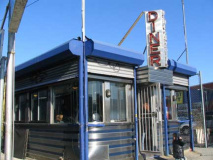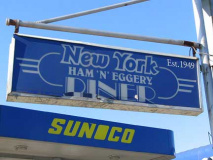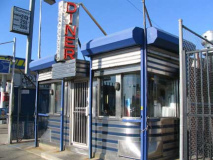In its October 12-18th, 2006 issue, Time Out New York (which featured a cover story by your webmaster in its September 21-27th issue) presented its 50 Best Blocks of NYC story, with North Portland Avenue between Lafayette and DeKalb Avenues in Fort Greene, Brooklyn coming out the winner.
It has spawned a debate in ForgottenLand (my head) in which I’m trying to think of my own NYC favorites. I could mention my old block, 73rd Street between 6th and 7th Avenues in Bay Ridge. It was quiet, which fits one of my criteria, and the block contained a historic relic: old Stewart Avenue, one of the aboriginal roads of Bay Ridge, traveled before the latterday street grid was laid down. And I liked the architecture, for reasons I’ll explain later.
I was in LIC to shoot one of my favorite subjects, a classic chrome diner whose existence I’d never suspected…when I happened upon what I’ll call my favorite blocks in Queens, and until they’re dethroned, in the rest of the boroughs as well.
What are your favorite blocks?
Blue Crystal
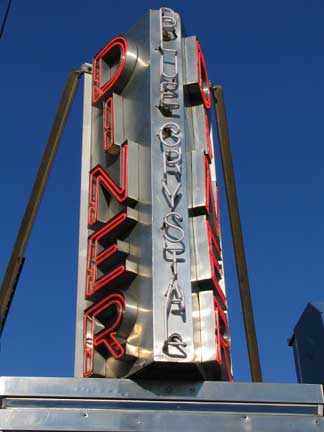
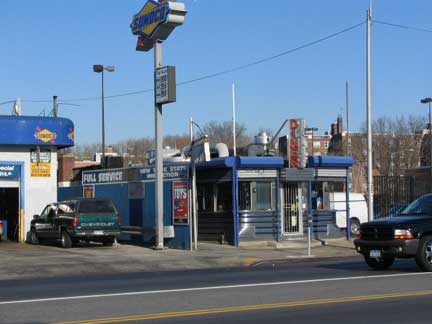
I had been down this stretch of Northern Blvd between 49th and 50th Streets in Long Island City quite a number of times since my move to the Biggest Borough in 1993 but I must have had blinders on; I hadn’t noticed the hole-in-the-wall Blue Crystal Diner at all whenever I had gone past (admittedly I am generally traveling underground in the subway, or via the LIRR when passing through.) It’s a gem in a genre that I am occasionally obsessed with, to the probable elevation of my cholesterol count.
Yes, I’m quite aware now of the Blue Crystal’s latterday name, the Ham ‘N’ Eggery, but with due regard to its current owner, Mario Monti, I much prefer the old Blue Crystal name…it’s very evocative, especially when the diner, with its blue and chrome color scheme, is captured on a cold, blue-steel severe-clear winter afternoon when the azure of the sky perfectly complements the diner.
The diner was built in 1949 by the Mountain View company of Singac, NJ, which was in existence between 1939 and 1957. Several Mountain Views are scattered around in NYC and across the country.
I didn’t have time to sample the fare but I can be fairly confident that I’d have no problems with it; this is a city with the greatest and most varied cuisine available anywhere in the world. Yet I have my tastes and stick to them. It may be pathetic, but I know what I like.
WAYFARING MAP: QUEENS’ BEST BLOCKS – NEWTOWN ROAD
Nonpareil
OK. I’m fine with naming 48th Street between Northern Boulevard and Broadway my favorite block in Queens. The streets of Long Island City, Ridgewood and to a lesser degree, Woodside, are lined with blond bricked Matthews Model Flats, each unit produced for $8000 in 1915 by Gustave X. Mathews, who is virtually unknown today but responsible for much classic residential architecture in Queens. The distinctive yellow bricks were produced in the kilns of Balthazar Kreischer’s brick works in the far reaches of Staten Island. (The Kriescher and Long Island City stalwarts, the Steinways, were linked by marriage.)
48th Street here is lined on both sides with uninterrupted vistas of Mathews Flats, giving a tight, uniform streetscape.This stretch was featured in the 1981 Milos Forman film adaptation of E.L. Doctorow’s Ragtime, the only film featuring both Jimmy Cagney and Queens’ Fran Drescher.
By 1917, Mathews flats were in such demand that it’s said that if laid side by side the entire string of houses would reach 4.5 miles. All, you will notice, feature a distinctive Romanesque Revival arch window on the third floor, with the 2nd floor windows getting a less severe arch. Each house has 6 apartments with two units per floor.
Many of the 48th Street Mathews Flats have kept what must be their original double doors. Notice, though, that the ornamental carved filigree above the doors is different over each door. This must be how each unit was differentiated from the other. It’s a very subtle touch.
I can recall that in the 1960s, the edict came from the city or state that residential buildings had have their doorways lit. I’ve always been interested in lighting (witness your webmaster’s lamppost obsession) so I noticed straightaway what kind of lighting was installed. Most of the time, utilitarian, boring lights were installed, like the one on the right, but now and then, fancier ones like the one on the left would be used. On 48th, many of these have fallen into disuse.
I’m not a hagiographer. Even for things that I like I tend to show all their aspects, and the reader can decide if I’m all wet or making sense. Every few days, things aren’t pretty even on the best of blocks.
New York, unlike other cities in the USA and Canada, has never had a network of back alleys in which garbage is placed and pickups occur. Therefore, garbage is placed in front of buildings or at the curb for all to see and smell. (When Mayor John V. Lindsay assumed office in January 1966 he was greeted with a subway and bus strike and a sanitation and teacher strike two years later — what a welcome!)
There’s no solution in the offing for exposed garbage in NYC streets, yet over time, change has come in the form of plastic cans replacing metallic ones (a metal can is second from the left).
The lucky skunks living in the end units of Mathews Flats buildings — and other attached styles –often have a treat since the bookend units jut out to give residents a view of the entire block.
Quintessential New York scenes, no? The Mathews Flats extend around the corner onto Broadway. If Derek Jeter‘s cologne ad wasn’t there, you’d think the photo could be taken in 1946, not 2006. Well, except that the green and white street signs were adopted in 1986, and the green globes, signifying that this entrance is open 24/7, arrived in 1982. Still, those are the original IND 1930s light stanchions, and vintage mid-century deli sign.
[Unfortunately the deli sign was modernized early in the 2010s.]
Triple F
Under NYC Parks Commissioner Henry Stern, who served mainly under the Giuliani administration in the 1990s, virtually every green space received a name, and many older ones were revived. This small bit of vegetation at the triangle of Broadway, Newtown Road, and 48th Street was named for World War I hero Corporal Frank Farrell Fagan in 1932. Fagan enlisted in 1917 and participated in many key battles in France, which awarded him with the Croix de Guerre for bravery.
King of Kongs
The street art crew known as FLY ID, formed by Clark Kent in the 1980s, produced this tribute to Peter Jackson’s remake of the classic 1933 giant gorilla movie.
What’s he got in his right paw? A flashlight, Ban Roll-On, or what?
It’s a spray paint aerosol can. (Your webmaster was never a tagger.)
Newtown Road
Like a number of streets and roads in NYC, Newtown Road isn’t named for the neighborhood where it is, but for the neighborhood it runs to. And, like a number of NYC streets that run aslant the overall grid, it’s one of the older roads in the area. It is an Indian trail that became the main road to early Astoria settler William Hallett’s farm in the mid-17th Century, and to the treacherous Hell Gate, the east River crossing to Manhattan. Its eastern stretch that ended in the heart of Newtown, now Elmhurst, was called Hurlgate, or Hellgate, Ferry Road; later named for the town through which it passed, becoming Woodside Avenue.
At Newtown Road and 46th Street we find some older buildings that have odd angles. This is the last remnant of an old village called Middletown (likely called because it lay between old Astoria and Newtown) instituted in the 17th Century. In 1721 one of Queens’ first schools was located here at the confluence of Newtown and Old Ridge Roads. British and Hessian troops marched by the school during the American Revolution. A century later, some schoolboys found a cache of gold coins worth $840 in its walls, likely hidden during the Revolution.
Today, the school is long gone, but Old Ridge Road still exists in the form of a curving driveway (seen at right in photo right). Another piece can be found between 37th and 38th Avenues and 29th and 30th Streets, and an old house is still turned to face the now-disppeared road on 33rd Street south of Broadway.
Ancient villages and gold caches aside, Newtown and 46th has some striking architecture. Here’s a castellated corner building with casement windows (a Forgotten favorite) with terra cotta trim.
Newtown Road, heading northwest. Top: small house but look at the beautiful detailing, the arches over the doorway and the second floor windows, and the checkerboard within the arches. A small slice of perfection.
When your webmaster appeared at a NYC Photobloggers event at the Soho Apple store in June 2005, dude in the back row piped up and said, “don’t you like anything new?” Of course. I like this Western Queens Health Associates building on Newtown and 45th, with its glass front and pitched roof, it’s got style to burn and has Swingin’ Sixties written all over it.
OK, the Swingin’ Sixties were 40 years ago.
This otherwise conventional apartment building at 44-14 Newtown has to assume some odd angles indeed to squeeze into its strange lot. That;’s why I love streets that break the grid…they force architects into unconventional answers.
Why aren’t apartment buildings like this one constructed any more?
The Guardian
I was completely stumped when I found a garage, surrounded by a lawn, barbed wire and ragged windblown American flags. It wasn’t till I rounded the corner onto 31st Avenue that I discovered it was part of a private parking lot owned by a Mister Fiore. I then encountered a Guardian, a neighborhood resident dedicated to defending turf against perceived hostile outsiders.
“May I help you?” came a disembodied woman’s voice.
In New York City, “May I help you” means, “stop what you’re doing and go away, asshole.” (Corollary: in New York City, “Sir!” means “asshole.”)
“No, you most certainly may not.” I now tend to adopt an air of dismissiveness when dealing with Guardians.
“What are you doing?” she asked redundantly.
“I am taking pictures of your parking lot,” I answered from the public sidewalk in front of the lot.
There were no further provocations, but I’m prepared to be more insistent with Guardians.
Fantasy League Sports Bar, 44th Street and 31st Avenue, extending to Newtown Road. The luminaries need no introduction, but include two Yankees, including Jeter, the second time we’ve seen him here.
Hey, we’re in Queens, where’s the Met love? Seaver? Wright? Reyes? Hot Rod Kanehl?
More Mathews models on 44th Street north of 31st Avenue. (Around here all the street numbers can be found under N on a Bingo card.) Points deducted, since they don’t extend all the way down the block, lack the arched windows, and aren’t on both sides of the street.
Also, here are three modern scourges, SUVs lined up all in a row. They are so tall, they ruin many perfectly good shots I’ve intended to make over the years.
Any Forgotten Fans want to give me the 411 on why these vehicles are superior to regular cars? Do they drive better? I know they drink more gas than their smaller forebears.
Unfortunately, as attached houses, Mathews Models lack garages in the back, the only esthetically-minded solution to where to put an automobile. Today’s Fedders Specials are built with garages in the basement, or simple unpaved areas in front where the SUV goes. Neither is an attractive method of vehicle storage.
Your webmaster takes the train and walks, not wishing to risk being slammed into by an SUV. I would drive a Bug if I drove.
Another of Long Island City’s great multi-unit buildings, 31st Avenue and 43rd Street. In the 1920s and 30s, the golden age of multi-unit architecture, the transition was being made from Beaux-Arts to Art Deco and Moderne, and some striking houses appeared. Here is some great door detail, as well as falcons on the roof. What developer could pull this off today without complete cheeziness?
43rd Street between 30th and 31st Avenues is lined on its east side, and some of its west, with some very attractive attached houses that are not part of the Matthews canon. In this case, I’m unaware of the designer. Most are well-kept and contain their original attributes.
Most of the units are gently curved, yet follow the tradition that the end units differ, in this case with an angled edge.
Most of them preserve their wonderful original stoops and double entrance doors.
End of the Beginning
Most NYC maps misrepresent Newtown Road, erroneously showing it running into Steinway Street south of 30th Avenue. This is a mistake since Newtown trends north as it runs toward 30th, seemingly yanked by he magnetic pole, and its angle is steep so it runs into 30th in the short block between Steinway and 41st, ending at 30th with a flourish, as we will see. A few years ago, the Department of Transportation re-labeled the road as Newton Road, yanking the signs after residents pointed out the error.
The Flatiron Building at 5th, Broadway and 23rd in Manhattan is often mentioned as the first skyscraper and first great “triangle’ building, but there are so many around town. The best ones seem to thrust into the streetscape like the prow of a ship. This one is a Mathews Model and so appeared after 1915, and complements a group of geat Mathews on 41st between Newtown and 30th Avenue.
Many of my photographer friends don’t like to shoot during the winter. I enjoy it. The low sun angle means that everything has a shadow and you have more play between dark and light. But your window of opportunity is narrower. You have to finish up by about 3:00, or just about everything near the ground will be too dark. Professional photographers can compensate for this, but as a point and shooter, I realize I have to get out early. And, I’ve never been a hot-weather person, even though some of my pages have been done while I’ve been staggering around in 100-degree temperatures.
I lived in an attached yellow-brick apartment buildings like these (not Matthews Flats though) in Bay Ridge from 1982-1990. By far, it was my favorite living arrangement. It was a railroad flat and had both northern and southern exposure, so I could see both moon/sunrise and moon/sunset. Not to mention the Verrazano Bridge from the “media room” (my turntable, LP collection and receiver) and, if I squinted during the winter, the Williamsburg Bank Building from the bedroom. (It was officially a one bedroom, but the kitchen and living room were combined and I considered them two rooms.) Your webmaster was forced out when the owner used the old gag about his daughter needing the apartment. I was callow then. What they did was reno the place and then ask me back at double the rent. No thanks. I eventually wound up in fab Flushing.
Newtown Road ends here at Grand Court, at 30th Avenue. That, my friends, is not just a door, it’s an entrance. Like many LIC apartment house names, it holds a clue to the past. 30th Avenue used to be called Grand Avenue (nothing at all to do with Maspeth/Elmhurst’s Grand Avenue; that road was formerly called Grand Street and begins in Williamsburg).
Photographed December 9, 2006; page completed December 11, 2006
